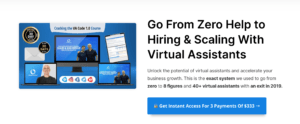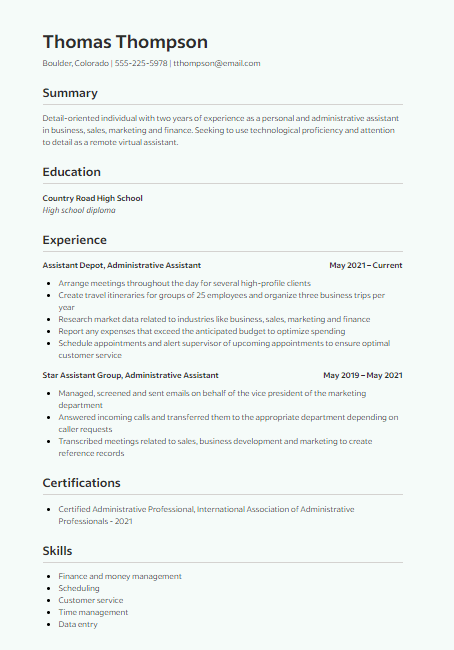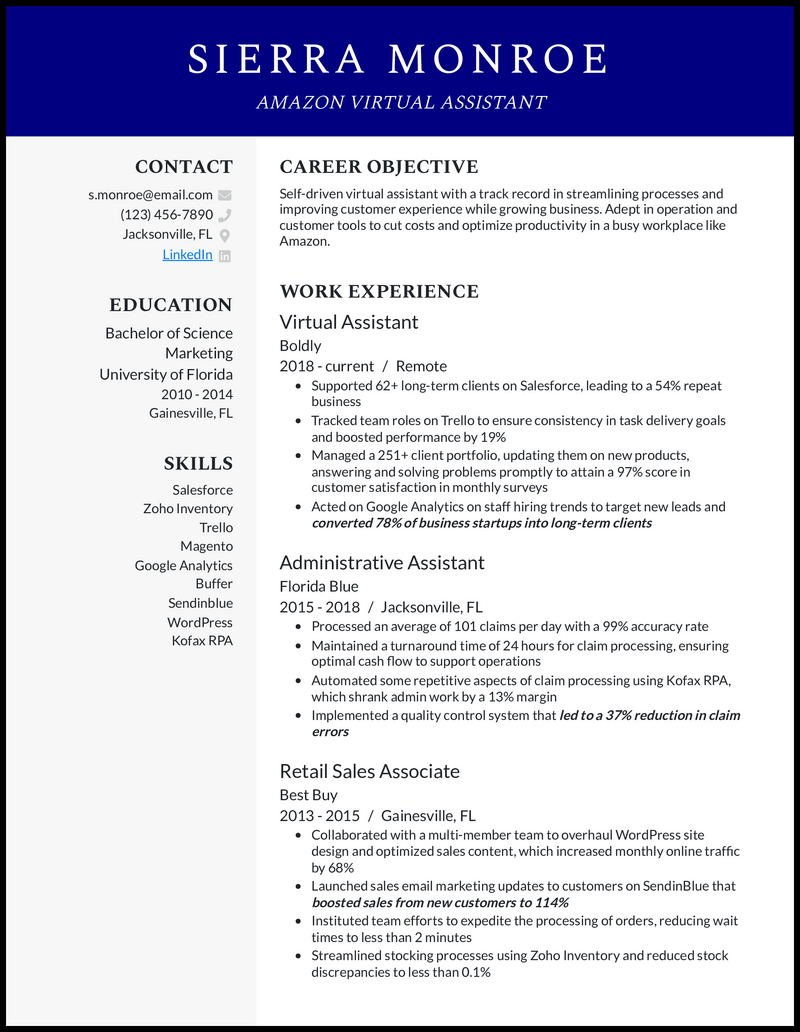
A resume cover letter may be one of the most important letters you have to write. But what is it and how should you write one?
The job market is extremely competitive. With outsourcing and VA hiring becoming more common, the number of potential candidates has grown. How can a cover letter benefit you and catch the attention of hiring staff?
In this post, we are going to cover
- What is a Cover Letter?
- Purpose and Importance of a Resume Cover Letter
- When to Write a Cover Letter?
- Formatting Your Resume Cover Letter
- Tips for Writing a Compelling Virtual Assistant Cover Letter that Complements your Resume
What is a Cover Letter?
A cover letter, also known as an application letter, is correspondence sent as part of a job application. You usually send this to employers together with a resume. Unlike a letter of interest, a cover letter is for an advertised job opening.
Purpose and Importance of a Resume Cover Letter
In a different post, we talked about virtual assistant resumes and how they help you market your skills and experiences. So what about cover letters? Why would you write one?
There are a few benefits and reasons to write a cover letter alongside your resume.
For one, it’s more personal than a resume. A resume is a lot more technical. Through a letter, you can introduce yourself in a more personal way. You can convey your interest in the job position in a way that displays personality and emotion. At the same time, you can still be professional.
Second, a cover letter can help you convince those in charge of hiring that you are the best candidate. The goal of both resumes and cover letters is persuasion. However, the format of cover letter writing is more flexible and allows you to communicate more using persuasive writing. You can show how well you connect to and qualify for the role. A cover letter allows you to express why you want the position, convince them to follow up, and consider you for an interview.
Third, you have a chance to expand on key skills or experiences listed on your resume. You can tell them what exactly you bring to the table. Anecdotes and stories with real quantifiable results are a great way to do this.
Fourth, it shows your ability to communicate. A letter gives a better glimpse into your ability to convey information, ideas, and enthusiasm. It’s especially beneficial if English-speaking skills are a requirement. Not only can you supplement your resume, you also meet a requirement on the job brief. That can definitely improve your chances of getting an interview.
Lastly, you can use your cover letter to help you explain certain red flags on your resume. For instance, employment gaps are something recruiters or hiring managers notice right away. This can be concerning because they don’t know what could have happened during that time. Instead of trying to hide it, you can explain the reason behind it.

When Should You Write a Cover Letter?
While we do believe a virtual assistant cover letter is important, it’s not always necessary. Cover letters and resumes usually come in pairs. So, it’s a good idea to check if the job post mentions anything about a cover letter. Some mark it as a requirement, others say it’s optional, and some tell you not to send one. Job posts may not even mention it at all.
So, what situations would you write or send a cover letter?
- If they request for one
- If there are gaps in employment history or other things you need to explain
- If the company you are applying to are mission-driven and goal-oriented
Tip: If it is optional or not mentioned, weigh the pros and cons of writing one.
Before you start writing, consider:
- Would the cover letter be something that improved your chances of getting an interview?
- Would your resume stand better by itself?
- Is there even a way for you to send the cover letter?
Formatting Your Resume Cover Letter
Header
Similar to your resume, your heading includes the essential information the hiring managers need to contact you. This includes your email address, phone number, and perhaps even a LinkedIn profile. You can also include your address.
Professional Greeting
It can be tempting to go with the cookie-cutter option of “To Whom it May Concern”. I remember this being taught from middle school all the way up to my high school senior year. However, this isn’t actually the best way to address your cover letter. It could even slightly lower the chances they read your letter. A cover letter is meant to be a more personal application for a job. Aligning with that, you should also use a greeting that is more personal without being unprofessional.
The best way to do this is to address hiring managers by name if possible. If you cannot find their names, then a simple “Dear Hiring Managers” will do.
Introduction Statement / Paragraph
Like bait on a hook, introductions are meant to reel you into the rest of the content. In a cover letter, the introductory statement is usually a 2-3 sentence paragraph that does a number of things.
To grab attention in this context, there are a few things you can do:
- Introduce yourself
- Describe yourself using soft skills (organized, creative, resourceful, etc. )
- Mention the job or position you are applying for
- Provide a brief history of your experience or qualifications
- Write in the appropriate tone used by the company
- Display enthusiasm for the job and confidence in your abilities
Body
Getting attention can sometimes be easier than keeping it. The body should be the most persuasive part of your virtual assistant cover letter.
Here you can detail experiences, qualify your skills, and quantify your accomplishments. However, just because this makes up the bulk of the letter, doesn’t mean you need to or should be wordy.
Your letter should not be longer than a single page with readable font choice and size. A safe example is Times New Roman 12. Make sure, also, to include a margin and to separate your paragraphs.
Conclusion
Your conclusion can be a summary of your letter. It can also be where you express your desire and excitement towards the possibility of working for that company.
Call to Action
You can combine this into your conclusion or this can be a separate sentence after. Simply, this is where you subtly suggest a course of action that the interviewers can take.
For instance, you can redirect their attention to your contact information should they need to reach you for a follow-up. You can also express interest in discussing things further through an interview.
Professional Sign-Off
You can then end with any of the sign-offs below. Use your best judgment based on the tone of the letter. Then end the whole letter with your name once again at the end.
- Sincerely (most recommended)
- Regards
- Best
- Respectfully
- Thank you
- Thank you for your consideration
Note: This is the general format that most cover letters will follow. However, always check and see if they mention any formatting rules. If they do, always prioritize those rules.
Tips for Writing a Compelling Virtual Assistant Cover Letter that Complements your Resume

Write Them Together
Just like you should tailor your resume to the job description, you should also write your cover letter alongside these two. Remember, you’re submitting a cover letter with your resume, so they should support one another. The cover letter should not be a reiteration of resume information, but rather an expansion or explanation of the information.
Include Work Anecdotes/Describe a Work Experience in Greater Detail
Through your resume, you can show the quantifiable results of your time with a company. A cover letter allows you to go into deeper detail. You can provide more context surrounding an experience that you believe will stand out to the hiring manager. This is a way to show how you problem-solve and come up with effective courses of action. You can also add more quantifiable data you may not have been able to in your resume.
Describe Your Experiences in Job-related Organizations
If your resume mentions your membership to a well-respected organization, you can include your related accomplishments in your cover letter. You can also mention any contests or events you have been a part of. Make sure, though, that these achievements are relevant and will be valuable information to the hiring manager.
Use the Same Keywords and Language
Use the language, tone and keywords used in the job description and resume. This shows those in charge of recruitment that you read and understood the post well. Not only that, but it also signals you will be a good fit for the team. It can indicate your ability to adapt to work culture. Using the same language also reveals your ability to maintain consistency. Anybody can use a template for resumes. However, if your cover letter is just as well-written as your resume, that’s a green flag. It also makes it much easier for hiring managers to go back and forth between your resume and cover letter.
What Is Outsource School?

Outsource School helps you to unlock the potential of virtual assistants and accelerate your business growth.
This is the exact system Outsource School’s founders, Nathan Hirsch and Connor Gillivan, used to go from zero to 8 figures and 40+ virtual assistants with an exit in 2019.
Since being founded in 2020, Outsource School has helped 1,000+ business owners hire 2,000+ virtual assistants for their companies.
Schedule a free sales call to learn more
Free resources you might like:
- Outsource School Case Study: How We Scaled to 45+ VAs and 8 Figures in Revenue
- Free VA Calculator | See How Many VAs You Can Afford
- Free Training on 5 Keys to Working With VAs
- Learn Outsourcing 101 | Guides, Downloads, and Checklists
Conclusion
A resume cover letter takes the facts in your resume and attaches it to a personality. Show employers how impressive you are but also show them that you are more than numbers or figures. A cover letter is also a great way to let employers know how eager you are for the job position. It’s a great way to convince them how well a partnership could work out between you and the company.
On the other side, are you a business owner trying to make better hires?













































 9. Regulatory Compliance Checks
9. Regulatory Compliance Checks